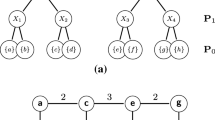Abstract
The classical morphological segmentation paradigm is based on the watershed transform, constructed by flooding the gradient im- age seen as a topographic surface. For flooding a topographic surface, a topographic distance is defined from which a minimum distance algo- rithm is derived for the watershed. In a continuous formulation, this is modeled via the eikonal PDE, which can be solved using curve evolution algorithms. Various ultrametric distances between the catchment basins may then be associated to the flooding itself. To each ultrametric dis- tance is associated a multiscale segmentation; each scale being the closed balls of the ultrametric distance.
Access this chapter
Tax calculation will be finalised at checkout
Purchases are for personal use only
Preview
Unable to display preview. Download preview PDF.
Similar content being viewed by others
References
S. Beucher and F. Meyer. The morphological approach to segmentation: the water-shed transformation. In E. Dougherty, editor, Mathematical morphology in image processing, chapter 12, pages 433–481. Marcel Dekker, 1993.
R. Kimmel, N. Kiryati, and A. M. Bruckstein, “Sub-Pixel Distance Maps and Weighted Distance Transforms”, J. Math. Imaging & Vision, 6:223–233, 1996.
R. Malladi, J. A. Sethian, and B. C. Vemuri, “A Fast Level Set Based Algorithm for Topology-Independent Shape Modeling”, J. Math. Imaging and Vision, 6, pp. 269–289, 1996.
P. Maragos, “Differential Morphology and Image Processing” IEEE Trans. Image Processing, vol. 78, pp. 922–937, June 1996.
P. Maragos and M. A. Butt, “Advances in Differential Morphology: Image Segmentation via Eikonal PDE & Curve Evolution and Reconstruction via Constrained Dilation Flow”, in Mathematical Morphology and Its Applications to Image and Signal Processing, H. Heijmans and J. Roerdink, Eds., Kluwer Acad. Publ., 1998, pp. 167–174.
F. Meyer, “Integrals and Gradients of Images”, Proc. SPIE vol. 1769: Image Algebra and Morphological Image Processing III, pp.200–211, 1992.
F. Meyer, “Topographic Distance and Watershed Lines”, Signal Processing, 38, pp. 113–125, 1994.
F. Meyer and S. Beucher, “Morphological Segmentation”, J. Visual Commun. Image Representation, 1(1):21–45, 1990.
L. Najman and M. Schmitt, “Watershed of a Continuous Function”, Signal Processing, vol. 38, pp. 99–112, July 1994.
S. Osher and J. Sethian, “Fronts Propagating with Curvature-Dependent Speed: Algorithms Based on Hamilton-Jacobi Formulations”, J. Comput. Physics, 79, pp. 12–49, 1988.
E. Rouy and A. Tourin, “A Viscocity Solutions Approach to Shape from Shading”, SIAM J. Numer. Anal., vol. 29 (3), pp. 867–884, June 1992.
J. A. Sethian, Level Set Methods, Cambridge Univ. Press, 1996.
P. Verbeek and B. Verwer, “Shading from shape, the eikonal equation solved by grey-weighted distance transform”, Pattern Recogn. Lett., 11:618–690, 1990.
L. Vincent and P. Soille, “Watershed In Digital Spaces: An Efficient Algorithm Based On Immersion Simulations”, IEEE Trans. Pattern Anal. Mach. Intellig., vol. 13, pp. 583–598, June 1991.
C. Vachier. Extraction de Caractéristiques, Segmentation d’Image et Morphologie Mathématique. PhD thesis, E.N.S. des Mines de Paris, 1995.
F. Zanoguera, B. Marcotegui and F. Meyer, “An interactive colour image segmentation system”, Wiamis’99: Workshop on Image Analysis for Multimedia Interactive Services, pp.137–141. Heinrich-Hertz Institut Berlin, 1999.
F. Meyer. Minimal spanning forests for morphological segmentation. ISMM94: Mathematical Morphology and its applications to Signal Processing, pages 77–84, 1994.
Author information
Authors and Affiliations
Editor information
Editors and Affiliations
Rights and permissions
Copyright information
© 1999 Springer-Verlag Berlin Heidelberg
About this paper
Cite this paper
Meyer, F., Maragos, P. (1999). Multiscale Morphological Segmentations Based on Watershed, Flooding, and Eikonal PDE. In: Nielsen, M., Johansen, P., Olsen, O.F., Weickert, J. (eds) Scale-Space Theories in Computer Vision. Scale-Space 1999. Lecture Notes in Computer Science, vol 1682. Springer, Berlin, Heidelberg. https://doi.org/10.1007/3-540-48236-9_31
Download citation
DOI: https://doi.org/10.1007/3-540-48236-9_31
Published:
Publisher Name: Springer, Berlin, Heidelberg
Print ISBN: 978-3-540-66498-7
Online ISBN: 978-3-540-48236-9
eBook Packages: Springer Book Archive




